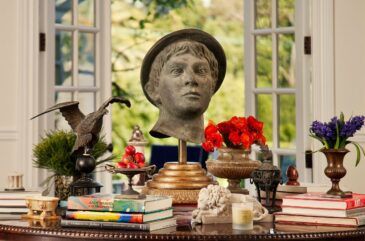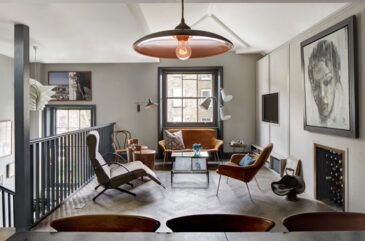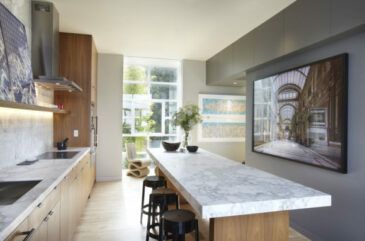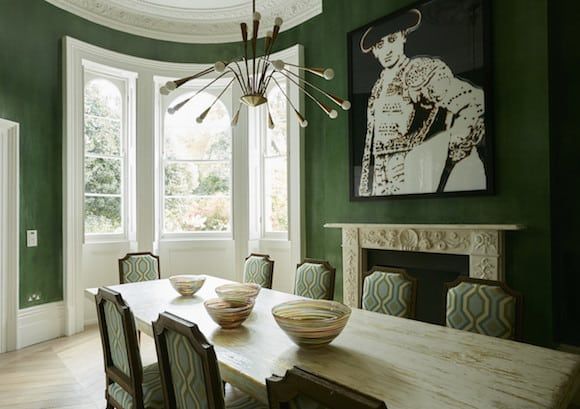
The formal dining room of a family house in Notting Hill is watched over by a Pop portrait of a matador. Photo by Ricardo Labougle
In 2011, two good friends joined forces to establish the buzzy Southeast London–based interiors firm Maddux Creative. With Scott Maddux’s background in architecture and Jo leGleud’s eye for fashion, the duo has a serious talent for creating spaces that suit their well-heeled clients’ tastes and lifestyles.
The firm’s signature look isn’t easy to condense, but one constant is its devotion to a bold, colorful amalgam of old and new woven together with unexpected touches of glamour. (Think: gilded chimneys, leather sofas, spinning mirror balls.) Both Maddux and leGleud oversee all concepts before their multidisciplinary team of six tackles everything from creating 3-D renderings and bespoke furnishings to consulting on art and antiques acquisitions.
Here, Maddux shares several pointers on what to contemplate when searching for the right pieces for a variety of art-hungry spaces.
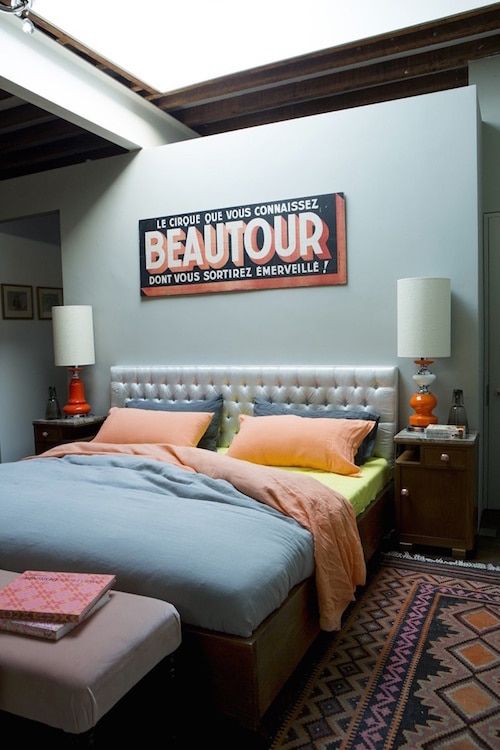
A loft-like bedroom in the Kensal Rise Factory building has a vintage circus sign over the bed. Photo by Ricardo Labougle
Should the mood of an artwork echo the look and feel of the room in which it will live?
Unless you’re a serious collector and your house is more a museum than a home, then yes.
If you’re outfitting an important room, the work needs to be something with a bit of gravitas. If it’s a decorative piece for a guest bedroom, it can be less important. For example, you could choose it based on color alone. Key pieces should always be chosen for something other than just decorative effect.
Important rooms don’t automatically have to be filled with gallery-grade works, either. I found this graphic, industrial-style circus advertisement — perfect for the space in that it echoes the home’s factory roots — at Ardingly Antiques & Collectors Fair in West Sussex.
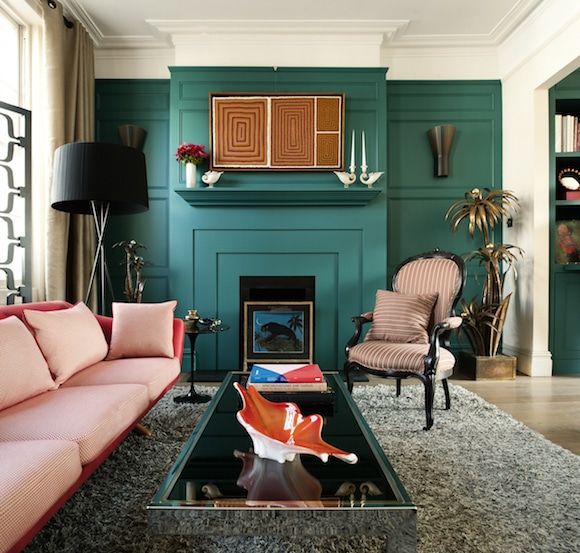
The living room of a house in Islington showcases an oil painting by Turkey Tolson Tjupurrula. Photo by Brotherton-Lock
What about the colors found within an artwork — should they interact with their surroundings?
I love to see work that plays with the surrounding color. In many contemporary environments, the walls are white and the art is on the walls — and that’s it. There’s no real interaction between the wall and the art! I prefer rooms with more of a layered approach.
If you’re designing around a piece, as we did in this Anglo-Australian couple’s living room, select a wall color that sets off colors found within the work. We’re often painting walls with darker, more intense colors. This teal color was chosen to balance the warm red tones within the homeowners’ beloved oil painting by Australian Aboriginal artist Turkey Tolson Tjupurrula. It’s an unexpected yet welcome relief from the all-white-wall approach.
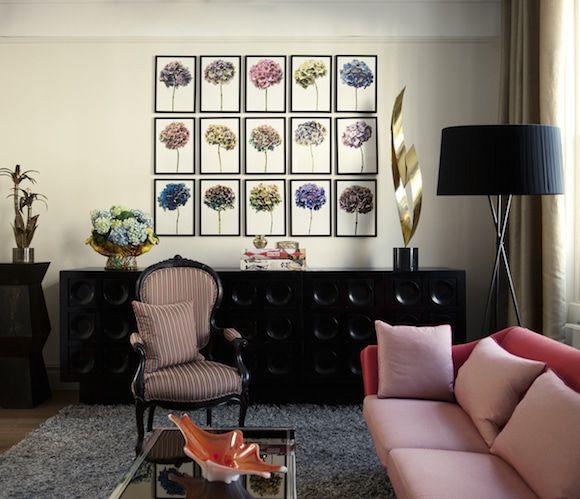
Another view of the Islington living room reveals a grouping of photos from Rachel Lévy’s hydrangea series. Photo by Brotherton-Lock
How integral is framing?
Frames have huge impact! Not only do they have the ability to totally transform a piece of art, but they instantly give works more significance. Sometimes, highly decorative frames can be just as important as the pieces within.
The way you hang pieces also matters. Thoughtful framing of not-so-important pieces looks great if the works are all hung together, in a gallery-style configuration. Don’t look to fill a wall with one giant piece. A gallery-style hanging is more interesting and effective.
In this Central London living room, we grouped 15 photos from Rachel Lévy’s hydrangea series, in simple, professional frames, and hung them in a grid. The result? A graphic, powerful display that really showcases the variations of colors in the photographs — precisely because their frames were downplayed.
What about buying off-the-shelf frames?
It’s okay to do. But it’s important to then fill them with custom mattes or mounts, revealing a sense of professionalism and continuity.
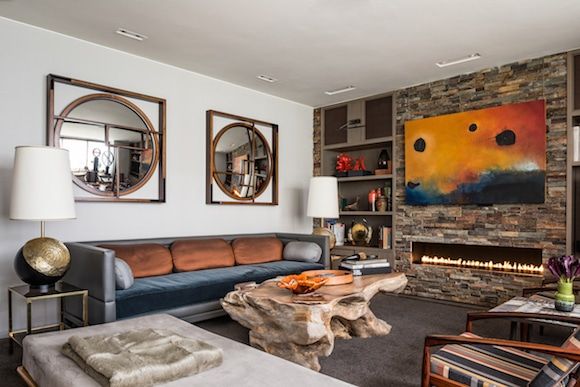
The living room of a house in Bayswater Mews accentuates organic forms and fiery hues in the furnishings as well as the art. Photo by Andreas Von Einsiedel
So how does one go about collecting, even if one doesn’t have an art budget, per se?
These days, it’s very important to have an art collection of some importance when you have a grand home, as many of our clients already do. But whether you’re growing your current collection or just starting on that journey, we always aim to acquire works that will remain with homeowners for years, to buy artwork that they’ve chosen for a reason and to select pieces that will inevitably grow into a larger body of work.
Keep in mind that what classifies even disparate works as a collection is the fact that they’re personal acquisitions. On one level, purely because you’ve chosen certain pieces, they relate to you somehow. You may not know what story the work is telling, but that’s all part of it. Start out buying smaller pieces as an easy way to find your footing as a first-time collector. Start small and keep growing!
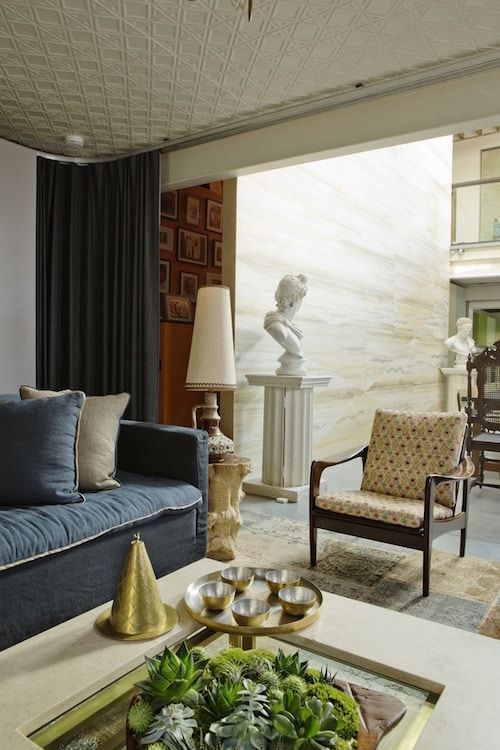
The living room of the Kensal Rise Factory home is guarded by sculptural busts on classical plinths. Photo by Ricardo Labougle
How does the scale of a space, as it relates to the piece, factor in?
This Southeast London home, in a former factory, is a great example of how we deal with scale. The residence was one enormous space before we began work on it, so our aim was to define specific areas and to make them more human-scale.
Here, we used large busts, plinths and three-dimensional objects to frame out individual spaces.
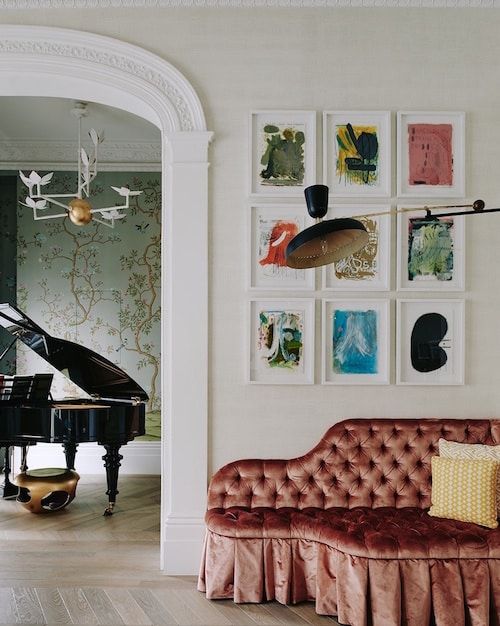
A living room in the Notting Hill house features a grid of Sebastian Helling works above a reproduction recamier lounge. Photo by Michael Sinclair
Would you recommend juxtaposing dissimilar pieces?
Some of the most interesting collections are highly eclectic ones. When I see this in my clients’ homes, I say, “I don’t quite know what you’re thinking, but I love that you put these together!” I love creating unexpected moments, and specifically, mixing contemporary art with classic things is so wonderful.
In this Northwest London home, we placed the family’s collection of nine, very ’90s-style graffiti works on paper by Sebastian Helling right above the pink, old-fashioned, reproduction recamier lounge we designed to fit into this corner.
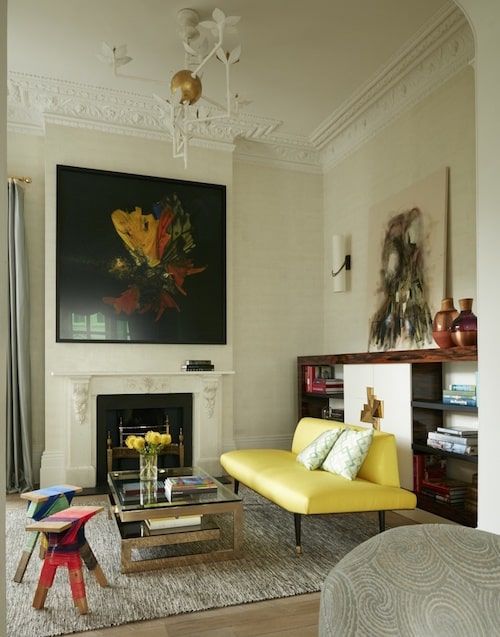
Another view of the Notting Hill living room reveals contrasting yet complementary works by Mat Collishaw (above the mantel) and Ross Chisholm. Photo by Ricardo Labougle
When the homeowners acquired the large, contemporary butterfly-wings photograph by Mat Collishaw, we knew it had to sit over that fireplace mantel. To the right of the photo is a very gestural oil painting by Ross Chisholm. It’s a great counterbalance to the slickness of Collishaw’s photo.
A good photograph can instantly make a room feel contemporary, even in a room full of plastic furniture.
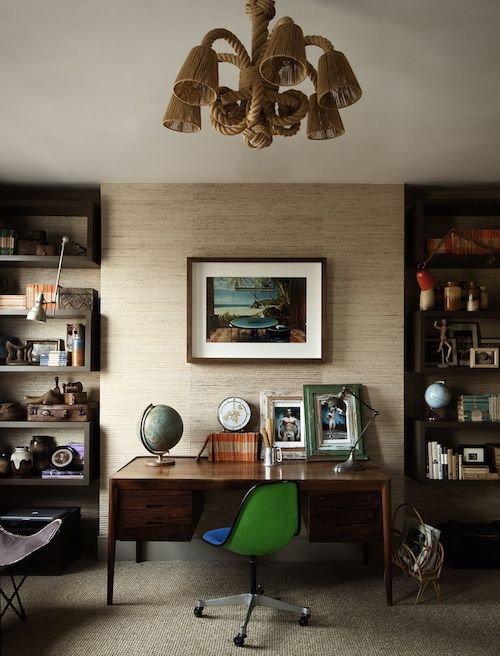
A guest bedroom in the Islington house is punctuated by color photographs that carry on the nautical theme. Photo by Brotherton-Lock
Aside from galleries, where do you find great artwork?
Some of my prized personal pieces are those I’ve found in junk shops — from amazing oil paintings to sculptures. I particularly love anything well-made that reflects someone’s hand. You can find art objects in all sorts of environments. Markets, too, are very viable places for finding decorative works.
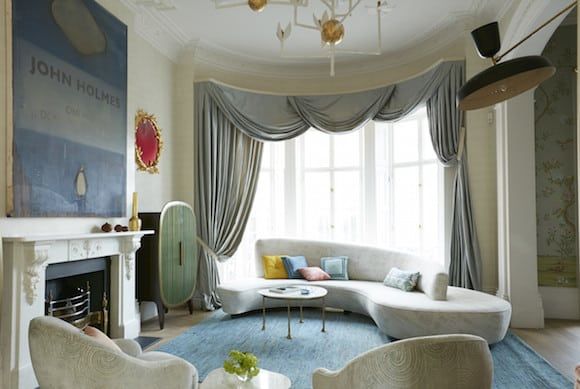
The Notting Hill living room also holds a Harland Miller canvas and a Vladimir Kagan sofa. Photo by Ricardo Labougle
What should one consider when buying art online?
If you have the chance to see the work in person, great. And if you can meet the artist in-person, it’s a welcome treat that can add yet another layer of narrative to the piece.
But you can actually get a good feel for what artwork looks and feels like, even online. These days, we’re so used to looking at images online. You can actually put together a pretty complete picture in your mind, and at a certain point you can take the plunge and be satisfied. Before you buy, here are some things to request and keep in mind:
Ask the artist or dealer for detailed, close-up shots.
Make sure you have an understanding of the scale of the piece, as well as its texture and surface.
Look at the piece from far away and from different vantage points.
Find out how it’s made and what it’s made of. It’s always good to have insight into an artwork’s process.
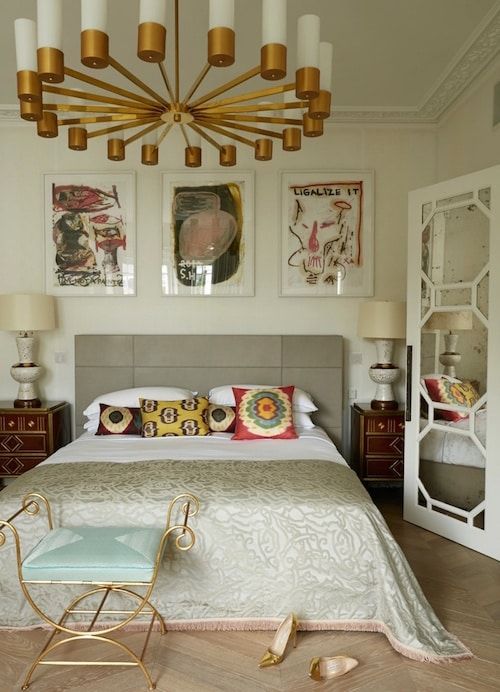
Neutral tones provide a counter balance to expressive works on paper in this bedroom of the Notting Hill home. Photo by Ricardo Labougle
How can you be sure a piece is the right one?
A piece doesn’t always need to make you happy, necessarily, but you should at least enjoy its energy. When you’re living with artwork in rooms you’re using every day, choose something that resonates. You need to feel something!
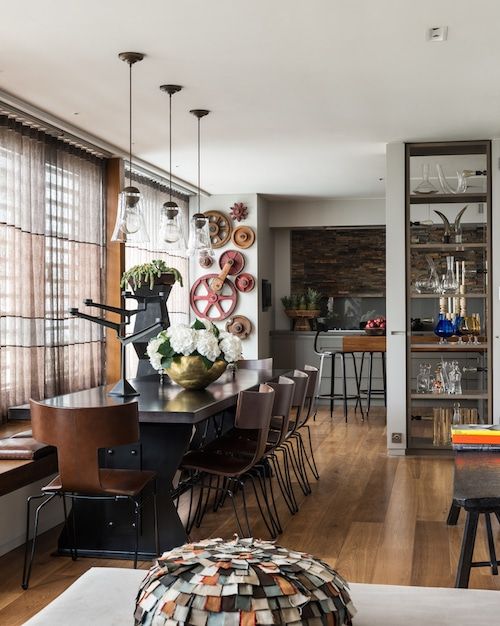
The Bayswater Mews dining room uses Industrial Era cogs as art. Photo by Andreas Von Einsiedel
Do you ever seek to elevate everyday items as objets d’art?
I’m a big fan of using plinths to elevate everyday objects into something extraordinary. We found a bunch of vintage wagon wheels and cogs in extraordinary colors at a market just outside Lille, in France, and placed them in the dining area of this West London home.
Here, we created an interesting wall-hanging composed of found objects. And to create motion in that little window, we arranged the wheels on plinths of varying heights. Found objects, too, can carry as much prestige as gallery pieces.

